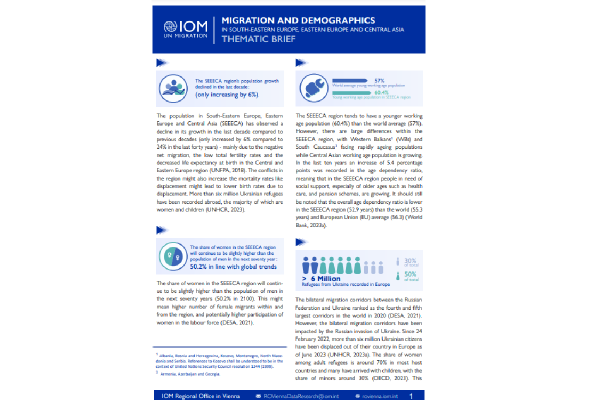Repository of Practices

Migration and Demographics in South-Eastern Europe, Eastern Europe and Central Asia – Thematic Brief
Dates
Type of practice
Summary
The population in the SEEECA region (South-Eastern Europe, Eastern Europe and Central Asia) has observed a decline in its growth in the last decade, mainly due to negative net migration, low total fertility rates and decreased life expectancy at birth in the Central and Eastern Europe region. After the COVID-19 pandemic, in 2022 and 2023, SEEECA experienced major demographic changes due to displacement caused by conflict and natural hazards such as the invasion of the Russian Federation of Ukraine in February 2022 and the earthquakes that hit Türkiye and northwest Syria in February 2023. Migration can play a key structural role in adjusting to demographic changes, labor market imbalances and economic fluctuations but to sustain economic growth, the working-age population must increase, labor-force participation rates must go up and/or productivity has to increase through technological advances and/or skills development. However, it is necessary to promote forward-looking immigration policies that allow larger numbers of migrants and consider their long-run impact.
Therefore, the idea behind having a Thematic Brief on “Migration and Demographics in the SEEECA region” was to provide IOM Missions in the SEEEECA region an updated data picture on trends and forecast population and migratory movements in the region, combining primary and secondary sources.
The initiative utilizes quantitative data from the following sources: UN DESA International Migrant Stock (2021) and UN DESA World Population Prospects (2023); UNHCR data on refugees and the Ukraine Situation (related to 2023); Federal State Statistics of the Russian Federation (2023) and Eurostat (2023); OECD data on the migration of health personnel (2023); ILO global estimates on migrant workers (2021); WB World Development Indicators (2023); data from the Disaster and Emergency Management Presidency (AFAD) and the Republic of Türkiye Ministry of Interior Presidency of Migration Management (PMM) (2023); and UNICEF data (2022).
The thematic brief was published in February 2024 and is intended to be a periodical product, now also covering the new IOM region of Europe and Central Asia.
Benefit and Impact
Positive secondary benefit is to have a clearer, up-to-date vision of the whole region, considering the multitude of studies and data summed up in a unique thematic brief. This thematic brief on demographic changes, projections, forced displacement, and labor migration enhances IOM's analytical capacity in migration management.
Key Lessons
Recommendations(if the practice is to be replicated)
Innovation
Additional Resources
Date submitted:
Disclaimer: The content of this practice reflects the views of the implementers and does not necessarily reflect the views of the United Nations, the United Nations Network on Migration, and its members.
More Related Practices:
- A Journey of a Thousand Mile Begins with a single Step: Djibouti’s Experience in Strengthening Migration and Displacement Data Governance
- A Gender-Focused Qualitative Study on Health Care-Seeking Behavior and Access to Tuberculosis Treatment among Mobile Populations from Moldova
- Migration and Demographics in South-Eastern Europe, Eastern Europe and Central Asia – Thematic Brief
- The Counter-Trafficking Data Collaborative (CTDC)
- Migrant Domestic Workers Rights on the Threshold of Czech Households
Peer Reviewer Feedback:
*References to Kosovo shall be understood to be in the context of United Nations Security Council resolution 1244 (1999).
Newsletter
Subscribe to our newsletter.